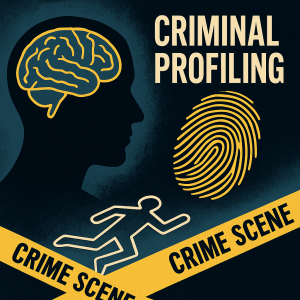
Psychological profiling, or criminal profiling, isn’t science fiction — it’s a vital investigative tool used by law enforcement agencies across the United States to understand and capture violent offenders. Though not always as flashy as shown on TV, real profiling uses behavioral patterns, crime scene analysis, and statistical models to narrow down suspect lists, anticipate future crimes, and provide insight into the criminal mind.
What Is Criminal Profiling?
At its core, profiling is the practice of analyzing evidence from crime scenes — such as the choice of victim, method of attack, and post-crime behavior — to develop a psychological portrait of the unknown offender. It helps investigators answer key questions: Was the crime planned or impulsive? Was it personal or random? Is the offender likely to strike again?
Profiling doesn’t produce names. It produces types: Is the killer organized or disorganized? Socially adept or isolated? A thrill-seeker or someone driven by compulsion?
And when used properly, this tool has helped solve some of America’s most infamous crimes.
Case Study #1: The Unabomber
Between 1978 and 1995, a mysterious figure sent package bombs to universities, airlines, and individuals, killing three and injuring 23. The FBI formed a task force known as UNABOM (University and Airline Bomber).
Criminal profilers analyzed the bomber’s behavior and writings, concluding he was a white male, highly intelligent, and likely had connections to academia. That profile led to a breakthrough when Ted Kaczynski’s brother recognized his writing style in a published manifesto and alerted authorities. Without the behavioral insights, Kaczynski might still be at large.
Case Study #2: BTK Killer
Dennis Rader murdered ten people in Kansas between 1974 and 1991. His crimes were brutal and erratic, making him hard to trace. But profilers observed a pattern: Rader craved control and recognition. He taunted police and media, needing to feel smarter than the system.
When he resurfaced in 2004, a profiler warned that his ego might drive him to slip up. Sure enough, he sent a floppy disk to the police — which led to his arrest. Profilers had nailed the one thing Rader couldn’t control: his need for attention.
Case Study #3: Green River Killer
The murders of dozens of women in the Seattle area during the 1980s left investigators overwhelmed. The FBI brought in profiler John Douglas (one of the pioneers of profiling), who described the killer as a blue-collar worker, socially awkward, likely with a history of sex work-related contact.
Douglas’s early profile closely matched Gary Ridgway, who was eventually convicted of 49 murders. Profilers helped narrow the list of suspects and shaped interrogation techniques that finally led to Ridgway’s confession.
Profiling Works Best with Other Tools
Profiling alone doesn’t solve cases. It’s a piece of a larger puzzle that includes forensic science, witness interviews, digital tracking, and good old-fashioned detective work. But it can offer vital direction when a case has no leads.
For example, in cases like the Washington D.C. sniper attacks in 2002, an inaccurate early profile nearly misled authorities. But when combined with forensic ballistics and tip-offs from the public, profiling helped refine the manhunt.
How Accurate Is It?
Critics point out that profiling has a mixed success rate and can sometimes reinforce bias. But agencies like the FBI’s Behavioral Analysis Unit (BAU) continue to refine the practice. When used by trained professionals, it can guide investigations, prevent future attacks, and — at its best — speak to the minds of killers when they refuse to speak themselves.
Leave a Reply